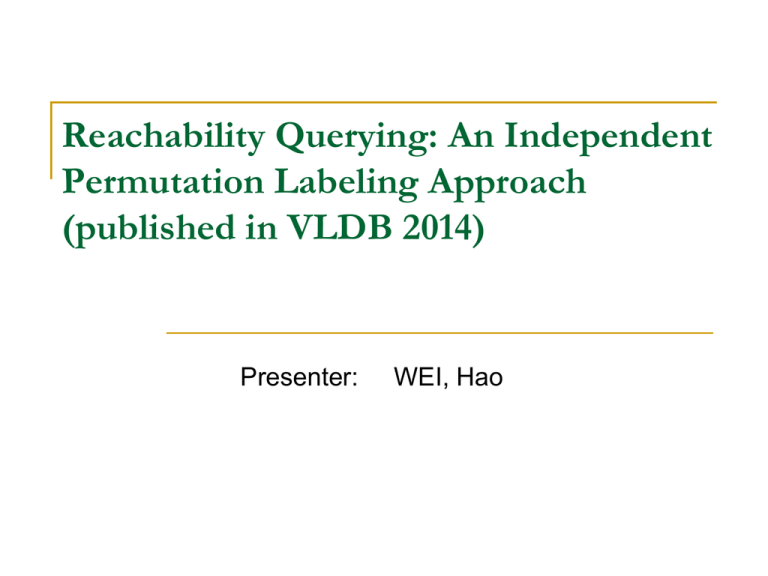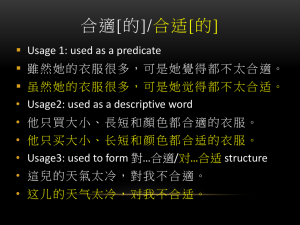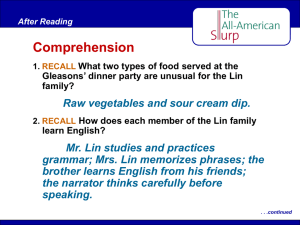slides
advertisement

Reachability Querying: An Independent
Permutation Labeling Approach
(published in VLDB 2014)
Presenter:
WEI, Hao
Graph Reachability Query
Given a directed graph G = (V, E) and two vertices u and v,
u is said to reach v if there exists a path from u to v over G.
Any
directed graph can be easily transformed into a DAG
trivial if u and v are in the same connect component
0
1
2
3
4
5
6
7
8
9
10
11
Query(v1, v8)
Reachable
Query(v2, v11)
Unreachable
The Issue and the Challenge
‘Big Data’ era brings us large
graph with millions of nodes and
edges.
web-uk dataset: 133 million
nodes, 5 billion edges
DAG of web-uk: 22 million
nodes, 38 million edges
Traditional approaches are not
applicable.
Related Work
Recent works builds index, label(u), offline for every node u.
Label-Only Approach: answer Query(u, v) only by label(u) and
label(v) only
Hop Labeling: TF-Label, Hierarchy Label, Distribution Label, …
Transitive Closure Compression: Chain-Cover, Tree-Cover, …
non-linear index construction time and index size, may generate
unacceptable large index
Label+G Approach: answer Query(u, v) by label(u) and label(v) with
the possibility of accessing G if needed
interval labeling: GRIPP, GRAIL, Ferrari, …
linear index size, but may perform DFS
Main Idea of IP Labeling
Out(u) denote the set of vertices that u can reach, including u itself.
In(u) denote the set of vertices in which every vertex can reach u,
including u.
u can reach v iff Out(v) ⊆Out(u) and In(u) ⊆In(v).
if Out(v) ⊈Out(u) or In(u)⊈In(v), u cannot reach v.
Both are time/space consuming if an exact answer is
needed for large sets.
Main Idea of IP Labeling
IP label aims to answer unreachable query pair (u, v) by
detecting Out(v) ⊈Out(u) or In(u) ⊈ In(v)
based on Min-wise Independent Permutation
high probability guarantee to answer query
linear index construction time and index size
Min-wise Independent Permutation
Given two sets 𝐴 and B ( Out(u), Out(v) or In(v), In(u) ) and a
random permutation 𝜋, according to the definition of
min-wise independent permutation,
Pr min 𝜋 𝐴
> min 𝜋 𝐵
=1−
|A|
|𝐴∪𝐵|
K-min-wise Independent Permutation
We propose to use top-k smallest numbers instead of
top-1 smallest number to improve the performance.
mink{π(X)} be the subset of π(X) containing up to the
k smallest numbers of π(X).
an order(≼) between mink{π(A)} and mink{π(B)},
such that mink{π(A)} ≼ mink{π(B)} if every π (bi) ∈
mink{π(B)} \ mink{π(A)} is larger than the largest
number in mink{π(A)} . We use mink{π(A)} ≻
mink{π(B)}otherwise.
K-min-wise Independent Permutation
We prove that
if mink{π(A)} ≻ mink{π(B)}is true, B⊈A
Let |A| = p, |A ∪ B| = q and |mink{π(A)}|= kA for kA ≤k,
Pr(mink{𝜋(𝐴)} ≻ min 𝑘 {𝜋(𝐵)} ) = 1
≈1−
𝑝 𝑘𝐴
(for q ≥ p ≫kA)
𝑞
𝑝! 𝑞−𝑘𝐴 !
−
𝑞! 𝑝−𝑘𝐴 !
Independent Permutation Generation
0
1
7
2
3
11
8
6
Knuth Shuffle
4
5
3
6
7
8
9
10
11
0
2
1
10
4
9
5
IP Label
The IP label of u consists of two parts:
Lout(u): the mink{ } set of Out(u), mink{Out(u)}
Lin(u): the mink{ } set of In(u), mink{In(u)}
IP Label
Vertex Lout
7
11
{2, 3, 4, 8, 10}
8
6
{2, 3, 4, 10}
{8}
3
0
{3}
2
1
{2, 10}
10
{10}
4
{4}
9
5
Lin
v0
{0, 1, 2, 3, 4}
{7}
v1
{0, 1, 2, 3, 4}
{11}
v2
{2, 3, 4, 8, 10} {7, 8}
v3
{1, 2, 3, 4, 6}
{6, 7}
v4
{2, 3, 4, 10}
{3, 6, 7, 8, 11}
v5
{0, 1, 5, 9, 10} {0, 7, 11}
v6
{2, 10}
{2, 3, 6, 7, 8}
v7
{1}
{0, 1, 6, 7, 11}
v8
{10}
{0, 2, 3, 6, 7}
v9
{4}
{3, 4, 6, 7, 8}
v10
{9}
{0, 7, 9, 11}
v11
{5}
{0, 5, 7, 11}
for k = 5
IP Label
Vertex Lout
Q1: Query(v2, v7)
0
1
2
7
9
10
Lout
≻ 3,
Lout
)
Lout
(v2(v
) 2=){2,
4,(v
8,710}
Lout
(v7) =7){1}
Out(v
⊈ Out(v2)
{0, 1, 2, 3, 4}
{7}
v1
{0, 1, 2, 3, 4}
{11}
v5
{0, 1, 5, 9, 10} {0, 7, 11}
v7
{1}
{0, 1, 6, 7, 11}
v8
{10}
{0, 2, 3, 6, 7}
v9
{4}
{3, 4, 6, 7, 8}
v10
{9}
{0, 7, 9, 11}
v11
{5}
{0, 5, 7, 11}
So Lout(v2) ≻ Lout(v7)
v6
{2, 10}
{2, 3, 6, 7, 8}
Out(v7) ⊈ Out(v2)
5
6
8
v0
8, 10} {7,
8}
1∉v2Lout{2,
(v23,) 4,
, 1∈L
out(v7) and
{1, 2, 3,than
4, 6} the
{6, 7}
1 vis3 smaller
largest
v4
{2,in
3, L
4, 10}
{3, 6, 7, 8, 11}
number
(v
2
)
out
3
4
Lin
11
for k = 5
IP Label
Vertex Lout
Q2: Query(v1, v3)
0
𝟏 𝟐
,
𝟐 𝟑
1
2
Lin
v0
{0, 1, 2, 3, 4}
{7}
v1
{0, 1, 2, 3, 4}
{11}
Letv2|A| ={2,p,3,|A
∪ 10}
B| ={7,q8}and
4, 8,
|min
for {6,
kA 7}<k,
v3k{π(A)}|=
{1, 2, 3, k
4,A6}
3
v4
{2, 3, 4, 10}
{3, 6, 7, 8, 11}
Pr(min
k{𝜋(𝐴)} ≻ min 𝑘 {𝜋(𝐵)} )
4
v5
= 1v6−
5
6
7
8
9
10
11
Lout
(v1) ≼ L out(v
Pr(L
(v33))) =
out(v1) ≻ Lout
Lin(v3) ≼Lin(v1)
2
Pr(Lin(v3) ≻ Lin(v1)) =
3
1
2
1, 5,𝐴9,!10} {0, 7, 11}𝑝 𝑘
𝑝!{0,𝑞−𝑘
𝐴
≈
1
−
(
)
10} 𝐴 !
{2, 3, 6, 𝑞
7, 8}
𝑞!{2,𝑝−𝑘
v7
{1}
{0, 1, 6, 7, 11}
v8
{10}
{0, 2, 3, 6, 7}
v9
{4}
{3, 4, 6, 7, 8}
v10
{9}
{0, 7, 9, 11}
v11
{5}
{0, 5, 7, 11}
for k = 5
IP Label
Vertex Lout
Q4: Query(v1, v3)
0
𝟏 𝟐
,
𝟐 𝟑
1
2
3
4
𝟏𝟒 𝟗
,
𝟏𝟓 𝟏𝟎
5
6
7
8
9
10
11
Lout
(v4) ≻ L out(v
Pr(L
(v33))) =
out(v4) ≻ Lout
Lin(v3) ≻Lin(v4)
9
Pr(Lin(v3) ≻ Lin(v4)) =
14
15
10
Lin
v0
{0, 1, 2, 3, 4}
{7}
v1
{0, 1, 2, 3, 4}
{11}
v2
{2, 3, 4, 8, 10} {7, 8}
v3
{1, 2, 3, 4, 6}
{6, 7}
v4
{2, 3, 4, 10}
{3, 6, 7, 8, 11}
v5
{0, 1, 5, 9, 10} {0, 7, 11}
v6
{2, 10}
{2, 3, 6, 7, 8}
v7
{1}
{0, 1, 6, 7, 11}
v8
{10}
{0, 2, 3, 6, 7}
v9
{4}
{3, 4, 6, 7, 8}
v10
{9}
{0, 7, 9, 11}
v11
{5}
{0, 5, 7, 11}
for k = 5
IP Label
Vertex Lout
Q4: Query(v1, v3)
0
𝟏 𝟐
,
𝟐 𝟑
1
2
3
4
𝟏𝟒 𝟗
,
𝟏𝟓 𝟏𝟎
5
𝟏𝟐𝟓 𝟓
,
𝟏𝟐𝟔 𝟔
6
7
8
9
10
11
(v55))≻≻LLout
(v33))) =
Pr(LLout
out(v
out(v
Lin(v3) ≻Lin(v5)
5
Pr(Lin(v3) ≻ Lin(v5)) =
6
125
126
Lin
v0
{0, 1, 2, 3, 4}
{7}
v1
{0, 1, 2, 3, 4}
{11}
v2
{2, 3, 4, 8, 10} {7, 8}
v3
{1, 2, 3, 4, 6}
{6, 7}
v4
{2, 3, 4, 10}
{3, 6, 7, 8, 11}
v5
{0, 1, 5, 9, 10} {0, 7, 11}
v6
{2, 10}
{2, 3, 6, 7, 8}
v7
{1}
{0, 1, 6, 7, 11}
v8
{10}
{0, 2, 3, 6, 7}
v9
{4}
{3, 4, 6, 7, 8}
v10
{9}
{0, 7, 9, 11}
v11
{5}
{0, 5, 7, 11}
for k = 5
IP Label
Vertex Lout
Q4: Query(v1, v3)
0
𝟏 𝟐
,
𝟐 𝟑
1
2
3
4
𝟏𝟒 𝟗
,
𝟏𝟓 𝟏𝟎
5
𝟏𝟐𝟓 𝟓
,
𝟏𝟐𝟔 𝟔
6
7
8
9
10
11
Lin
v0
{0, 1, 2, 3, 4}
{7}
v1
{0, 1, 2, 3, 4}
{11}
v2
{2, 3, 4, 8, 10} {7, 8}
v3
{1, 2, 3, 4, 6}
{6, 7}
v4
{2, 3, 4, 10}
{3, 6, 7, 8, 11}
v5
{0, 1, 5, 9, 10} {0, 7, 11}
v6
{2, 10}
{2, 3, 6, 7, 8}
v7
{1}
{0, 1, 6, 7, 11}
v8
{10}
{0, 2, 3, 6, 7}
v9
{4}
{3, 4, 6, 7, 8}
v10
{9}
{0, 7, 9, 11}
v11
{5}
{0, 5, 7, 11}
The probability increase significantly !
for k = 5
IP Label
Assume DFS is needed even though u cannot reach v.
Consider a vertex w, as a descendant of u, is visited by
DFS towards v, the followings are true:
Pr(Lout(u) ≻ Lout(v)) <Pr(Lout(w) ≻Lout(v))
Pr(Lin(v) ≻Lin(u)) <Pr(Lin(v) ≻Lin(w))
While DFS becomes deeper, it is much more likely to
answer the unreachability queries, and therefore, it can
stop in an early stage.
Two Optimizations
Level Label: use the topological structure to prune
the search space
Huge-Vertex Label: build additional index to handle
the huge vertices of the graph
Performance Studies
Real Dataset:
Dataset
| V(G) |
| E(G) |
davg
R-ratio
uniprotenc
25M
25M
0.999
1.30E-7
twitter
18M
18M
1.013
7.39E-2
web-uk
22M
38M
1.678
1.50E-1
citeseerx
6.5M
15M
2.295
4.07E-4
go-uniprot
6.9M
34M
4.990
3.64E-6
govwild
8.0M
23M
2.948
7.20E-5
Performance Studies
Index Construction Time (in second)
Dataset
TF-Label
DL
GRAIL
Ferrari
IP+
uniprotenc
58.529
22.280
58.242
24.292
18.96
twitter
15.291
13.719
32.323
19.972
12.44
---
24.240
44.031
26.927
17.46
citeseerx
91.877
12.045
23.170
19.792
7.54
go-uniprot
38.668
18.277
44.557
40.365
9.68
govwild
30.520
18.584
29.237
19.924
8.45
web-uk
Performance Studies
Query Time (in millisecond)
Dataset
TF-Label
DL
GRAIL
Ferrari
IP+
uniprotenc
119.164
119.618
820.249
116.351
54.205
twitter
102.923
104.698
---
82.212
79.285
---
146.429
---
214.857
253.082
citeseerx
230.318
111.329
28774
131.534
101.444
go-uniprot
55.279
153.214
499.505
313.300
34.577
254.785
128.199
719.494
295.432
112.990
web-uk
govwild
Performance Studies
Performance Studies
Distribution of the number of vertices visited
Conclusion
We propose a new IP labeling approach, the first one to
explore the randomness to answer reachability queries.
Our new labeling approach has linear index construction
time and index size. By independent permutation, the
query performance is guaranteed by high probability.
We analyze the performance of our proposed approach
by extensive experimental studies and our approach
shows both good efficiency and scalability.









